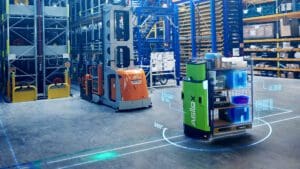
Heavy research and development investments are being made in supply chain solutions. These investments occur at the application layer, in technologies that will speed up implementations, and at the platform level. However, some of the larger providers of these solutions clearly consider platform investments core to competitive differentiation. Blue Yonder is investing $1 billion over three years in their solutions. Much of that investment is at the platform level.
Most of the large suppliers of supply chain applications have moved their solutions to the Cloud. A blog from Atlassian explains that “until about 2013, companies usually built enterprise software by constructing applications as single units with large codebases, a monolithic architecture. As software became more complex and cloud computing gained popularity, this approach became less practical.” Cloud-based solutions often were built with a microservices architecture. Atlassian develops products for software developers and project managers.
Microservices have several advantages. Developers could work in smaller, more specialized groups to improve a software component without risking the entire application. This sped up development and led to software with smaller but more frequent releases. This architecture improves upgrades. It allows the different components, previously located in a distinct application, to be assembled like Lego blocks into new composite applications
But Blue Yonder, makes the argument that when most vendors move to a new platform, their customers suffer initially. In the long run, the advantages of the new platform will provide significant benefits. In the short run, customers who implement the solution get a solution that has less functionality than the previous application. Executives at Blue Yonder refer to this as a “cliff event.”
To avoid a cliff event, Blue Yonder has proceeded by turning its supply chain applications into applications that are part traditional software code and part microservices. Every release will have net new functionality as well as existing functionality that has been componentized. Eventually, customers will have a completely modern micro-services solution while never having to experience a cliff event.
Microservices also open new sales opportunities. Blue Yonder, for example, has created a microservice for transportation optimization. Some clients may not want to buy a full-blown transportation management system, so Blue Yonder is willing to sell them a transportation optimization component and layer it on a legacy TMS or control tower.
Another advantage of microservices rarely discussed is that this architecture also allows clever new functionality to be created because the components are seamlessly integrated on a shared platform and data model.
For example, during the days of the monolithic solutions, vendors that had both warehouse management and transportation management systems would tout the new logistics efficiencies that were possible because they could provide both solutions. These claims were always overblown until the microservices revolution occurred.
Manhattan Associates, for example, has been gradually releasing microservices-based applications. Manhattan Active Warehouse Management was released in 2020, Active Transportation Management in 2021, and their Active Supply Chain Planning solution just this year. It was not until all of these applications were microservices enabled that we started to see the kind of clever new functionality that breaks down disconnects between what was planned and what can be executed.
At the Manhattan Momentum conference, Brian Kinsella, the senior vice president of product management, explained that if a promotion plan has not been correctly modeled for the warehouse, there may not be enough storage capacity, dock doors, or workers to execute the day’s work. However, a Manhattan Active SCP plan is built with an understanding of what the warehouse is capable of from the bottom up. In the case of a big promotion, the resulting plan can now be “smoothed” by beginning the execution of the plan days earlier. These new capabilities are based upon inside-the-box synergies. The new functionality is possible because data is being ferried back and forth between the components efficiently.
Adam Kline, the senior director of product management for WMS at Manhattan, strongly disagrees with any implication that their microservices-enabled WMS has any loss of functionality compared to their older WMS. “We spend four years rebuilding our WMS.” In the beginning, there were undocumented features they came across. “We treated them like bug fixes” and quickly added the functionality. But now, after four years, the Active WMS product “has 130% of the functionality of the old solution” because of the warehouse execution system, new optimization, and other features that have been added.
Blue Yonder has the same vision for inside-the-box optimization as Manhattan. Andrew Brazell, vice president of global supply chain execution solutions at Blue Yonder, says that more of their customers are looking to optimize the warehouse, transportation, and order management together. Before you drop an order to the distribution center, you need to know how the DC is behaving.” Blue Yonder is seeking to use AI agent technology, acquired in the One Network acquisition, to predict that the warehouse will not be able to finish picking and staging an order in time, “you, may want to fulfill out of a different DC or change to a different mode or shipment.” A good architecture allows feedback loops that improve the plan.
Blue Yonder recently completed the acquisition of One Network, paying approximately $839 million. One Network is one of the leading providers of supply chain collaboration network solutions. This acquisition can lead to better outside-the-box orchestration. The One Network platform gets data feeds from carriers, suppliers, and other supply chain partners in near real-time. One Network uses AI-based agents to predict whether an existing plan is likely to be disrupted by an event occurring up through the company’s extended supply chain. This means that impactful supply chain events that are not visible inside-the-box are now visible, and the supply chain solutions can better react to changing conditions.




















